
In This Case is a series of periodic posts on art in the Luce Foundation Center, a visible art storage facility at the Smithsonian American Art Museum that displays more than 3,300 pieces in fifty-seven cases.
Note that the image you see here is not a picture of One, Two, Three by Sol LeWitt, but rather of the maquette for the sculpture. The realized piece is approximately thirty feet in length; it sits in the James Hanley Federal Building in Syracuse (no link available). The much smaller maquette (about twenty-three inches in length) is located here.
I find slightly delicious the act of displaying a maquette for a LeWitt. People will tell you that the model is no substitute for the real thing, but LeWitt would be the last to endorse that sort of finger wagging. He's notoriously described the execution stage of the artmaking process "perfunctory"—the design, of course, being the true conceptualist piece.
Victoria Dawson wrote a Smithsonian Magazine piece about the pair of wall paintings painted—or installed?—at the Hirshhorn in 2003, and she hit all the right notes about how his pieces work. LeWitt, of course, confounds viewers' preconceptions about painting by outsourcing a work's execution, an aspect of painting that many long considered to be crucial without even really considering it—that is, that the artist herself applies the paint to the canvas, and it is a painting by the artist because it is her brushstroke, and so on. For a close look at the installation/painting process, be sure to check out Paul Schmelzer's recent piece about erecting LeWitt's Four Geometric Figures in a Room at the Walker.


















